Sailing Avocet: Comms Failure
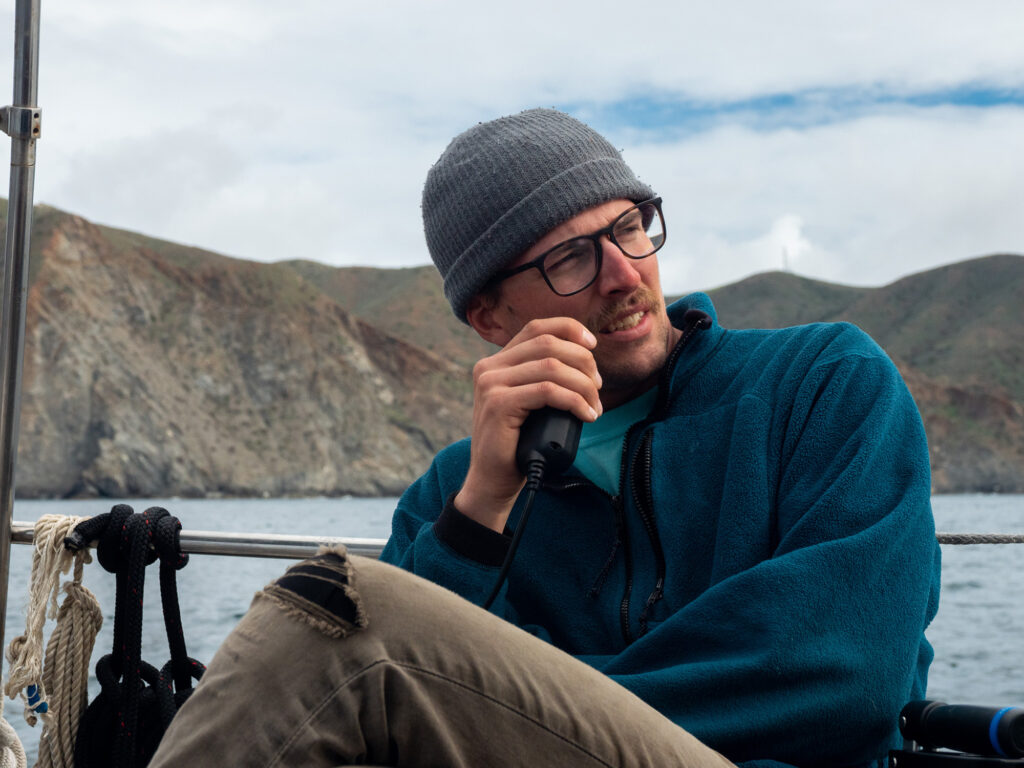 “Kessel, Kessel, Kessel, Avocet…”
Marissa Neely
“Kessel, Kessel, Kessel, Avocet…”
Marissa Neely
Ventura, California, to Cat Harbor was not the plan, but at that point, what was? Accepting the unexpected had certainly made me a more patient person, and I wasn’t necessarily opposed to stopping at Catalina. On the contrary, I was excited to spend our last days in the United States on the magic little island, even if it was all while waiting for parts to arrive by mail.
Somewhere between Morro Bay and the present, our Starlink decided to stop working. We were getting painfully slow download speeds in comparison to our buddy-boater friends. It wouldn’t do for this crew, since I am still running my business while we cruise. It was 5 a.m., and I was hoping to get some work done while we were sailing, but soon realized that without a proper connection, all I could do was shut my laptop in frustration and hope we could figure out the issue when we got to Cat Harbor.
It wasn’t the most comfortable sail in the world, on the tail end of a strong Santa Ana in confused seas. The chop was 5 to 6 feet, coming at us from all angles in addition to the predominant northwesterly swell. Our buddy on the 38-foot Hans Christian Kessel who had left at the height of the wind event, four hours before us, was now only about 10 nautical miles ahead. He had slowed down to ride out the swell during the worst of it, which unfortunately lasted longer than anticipated. Our 41-foot Cheoy Lee Avocet punched through the washing-machine chop, holding an average 6 knots with full canvas up. It was a bumpy ride, but we arrived at the anchorage an hour after Kessel, snagging a mooring just as the sun went down.
Cat Harbor is the deepest cove on the island and provides excellent protection for boats anchored or moored there. It is one of only two U.S. Coast Guard year-round safe harbors in Southern California. Since it was the offseason, we paid for two nights and got five for free, which, at $73 per night, seemed like a pretty good deal to us.
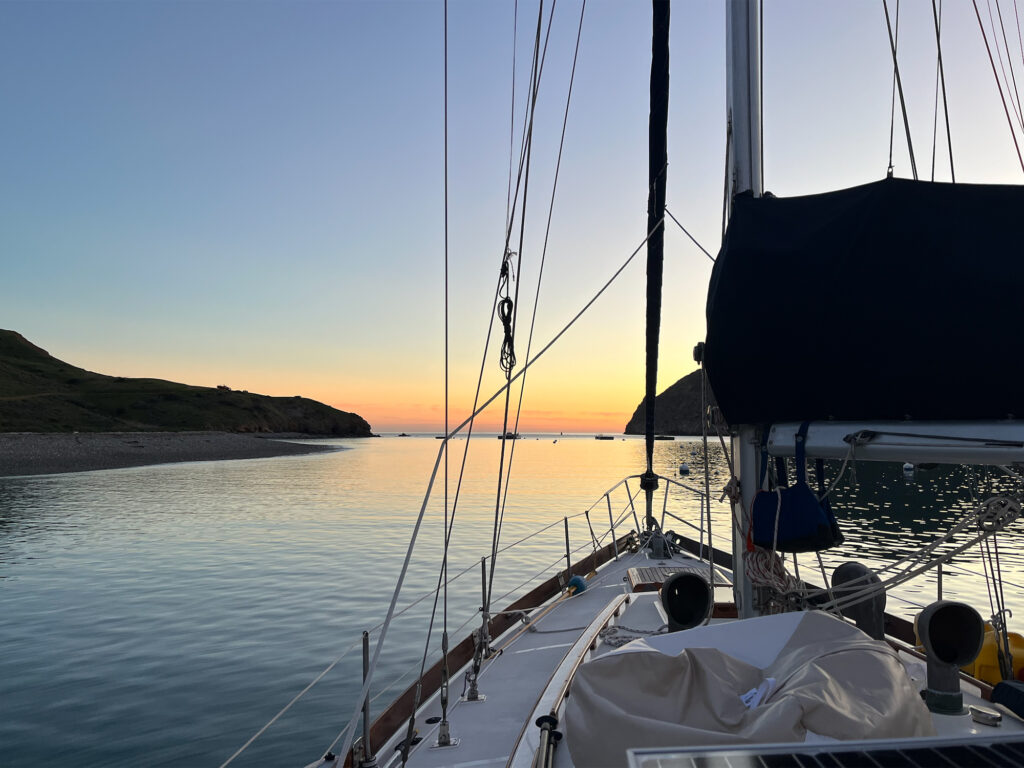 Catalina Harbor is the deepest cove on the island and provides excellent protection for boats anchored or moored there.
Marissa Neely
Catalina Harbor is the deepest cove on the island and provides excellent protection for boats anchored or moored there.
Marissa Neely
At this time of year, the isthmus is lightly reminiscent of our beloved Santa Cruz Island, especially in contrast to the hustle and bustle of the city of Avalon on the southwest side. Although there is some infrastructure (a bar, restaurant, laundry, restrooms, and kayak rentals) they are mostly inhabited by ghosts during the winter.
None of which would help with my Starlink problem. Going up the California coast, we had no issues, but after our stint in Morro Bay, our dishy never worked the same. After we slept off the rough passage, Peter Metcalfe from Kessel was aboard Avocet in the early hours of the morning to help us troubleshoot. He and my husband, Chris, shuffled between Kessel and Avocet all morning with various equipment, trying new cables and configurations. Chris filed a help ticket on the Starlink app and was pleasantly surprised to get a response within five minutes. The tech confirmed it was a hardware issue and arranged for new hardware to be sent to our address, which was still set as Safe Harbor Ventura Isle.
Fortunately, we had friends living aboard in the marina. They agreed to receive the package and were kind enough to send us their router in the meantime. Unfortunately, there was no good way to get to the Avalon Post Office from Cat Harbor in the offseason, but Chris was excited to try and ride the 40 mile round-trip-trail. His first attempt was rained out by a squall, so he decided it was probably best to sail the boat over for a night before sailing to Mexico. It was Friday and the post office would be closed over the weekend, leaving us with two full days to explore Cat Harbor.
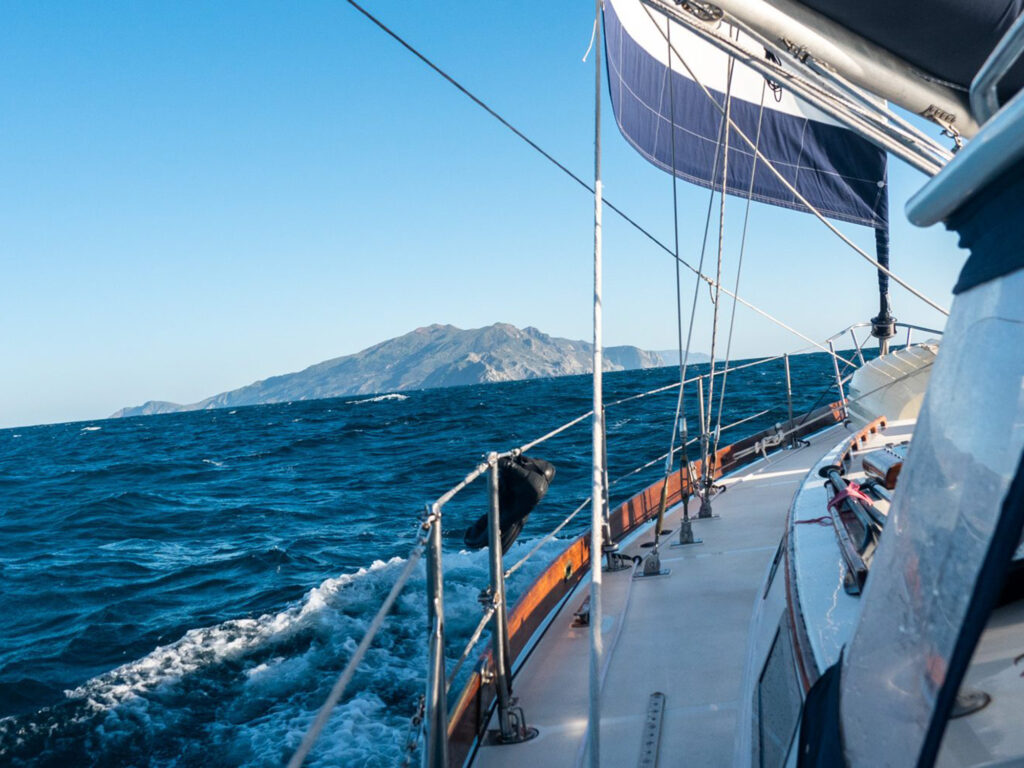 Catalina Island, here we come.
Marissa Neely
Catalina Island, here we come.
Marissa Neely
“Harlow no! Leave the Buffalo alone!” Peter shouted during our hike the next day, as one of his two Malinois pups tried to get up close and personal with a buffalo. A movie production had left 14 of them here in 1924, and they got pretty busy populating the island, with 150 buffalo here now. We encountered them on the Goat Whiskers Trail, which we hiked backwards, starting with the steep, sun-beaten ridge. Then we continued onward and upward, emphasis on upward.
“Did you pack your inhaler?” Peter asked with a chuckle as we began our ascent. Back in San Luis Obispo, I think I had a mild asthma attack when trying to hike Bishop Peak. I laughed through my panting, taking a swig of water before marching up to the next vista. With the recent rains, the island was painted in bright green with pops of wildflowers, all contrasting with the blue ocean. We encountered an abundance of native flora and fauna, what with the Catalina Island Conservancy having solicited sharpshooters in helicopters to execute all the goats back in the 1990s.
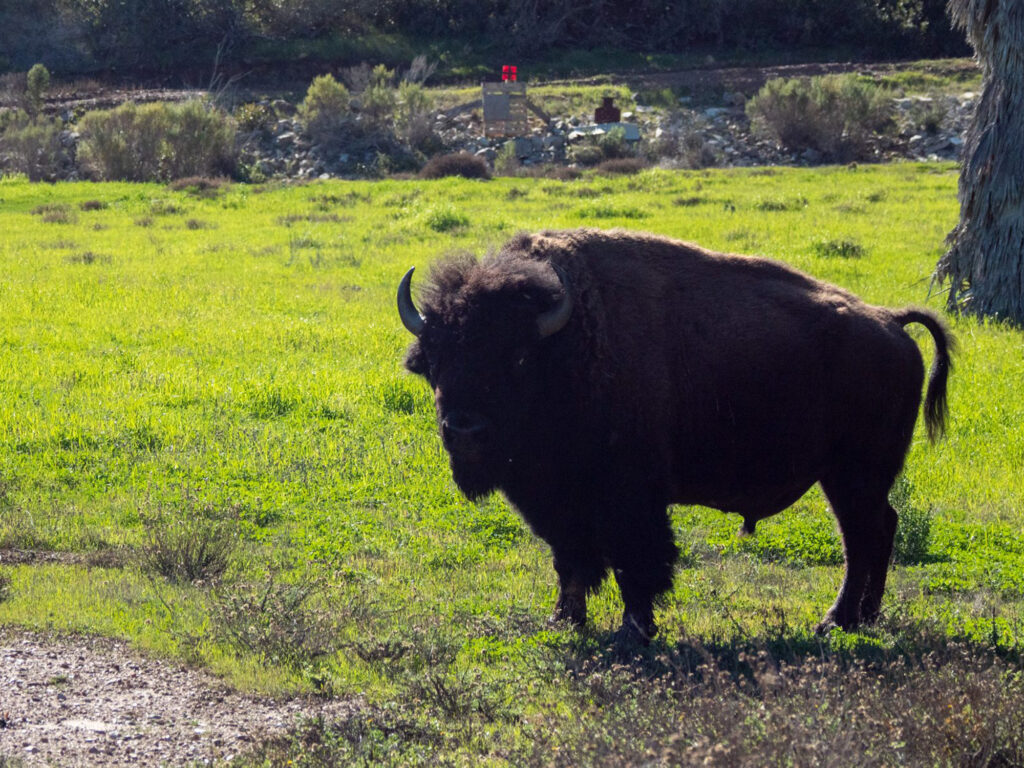 “Harlow, no! Leave the Buffalo alone!”
Marissa Neely
“Harlow, no! Leave the Buffalo alone!”
Marissa Neely
As we came to the top of the peak, we were greeted with the infinite view of the ocean to the west, and the mainland with snowcapped mountains to the east. The grandeur of the landscape and the island’s furrowed coast splayed open like a deck of cards, revealing unmatched views of Catalina’s wild side.
We were exhausted the following day, but Chris and I still managed to get out and stretch our legs, scrambling up a cliffside near our mooring. There was a lot of washout and unstable ground. To my delight, we foraged some fennel, California sage and the best surprise of all: pickleweed.
Back on Avocet, we turned on our water maker for the first time—it worked exactly as we had hoped, and our tanks were topped off within the hour. That evening, we brought our cat Cleo to shore to stretch her legs and get some enrichment, but she is not a fan of “outside,” so we were soon back to the boat sweet boat.
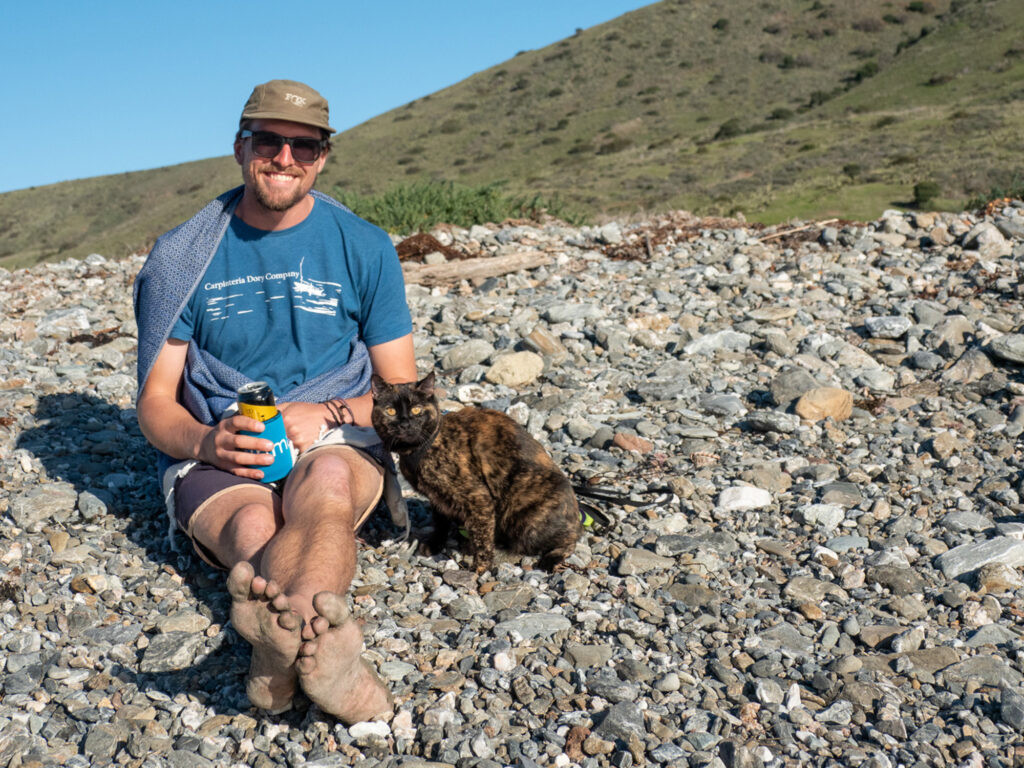 We brought Cleo to shore to stretch her legs and get some enrichment, but she’s not a fan of “outside,” so we brought her back to Avocet where she ran inside to curl up in a dark place.
Marissa Neely
We brought Cleo to shore to stretch her legs and get some enrichment, but she’s not a fan of “outside,” so we brought her back to Avocet where she ran inside to curl up in a dark place.
Marissa Neely
The wind caught our sails the moment we were out of the lee of Cat Harbor, giving us a good lead on our friends who were still maneuvering through the mooring field. The Kessel crew was now one member short. The salty life had not been suitable for their dog Harlow, who got a new life on land with a family.
“I see the tannies,” I said, watching through the binoculars as Kessel unfurled her tanbark genoa. Clouds formed on the horizon, quickly coming our way and growing darker. We short-tacked along the shore, sailing upwind down the coast in another southerly that seemed to be the norm for us at this point.
Catalina’s East Side is wild, with steep cliff sides speckled with bird nests and trees hanging on for dear life. The only “beach” we saw was filled with sea lions that barked across the water. We rounded the lowest point of the island, where Connolly-Pacific’s quarry came into view. The quarry, in operation since the mid-1900s, had supplied stone for many of the Southern California breakwaters.
Kessel passed us on a starboard tack and the wind started to die down, so both crews decided to motorsail to reach our destination on time. Chris hailed Avalon Harbor on VHF radio channel 12, but there was no response. Luckily we had cell service and got hold of them, right as the rain began to pick up. We danced circles alongside Kessel outside the breakwater, waiting for a patroller to guide us to our mooring ball. “You know there is a system coming through, right?” the patroller asked. We nodded and started to prepare mentally for a bumpy night.
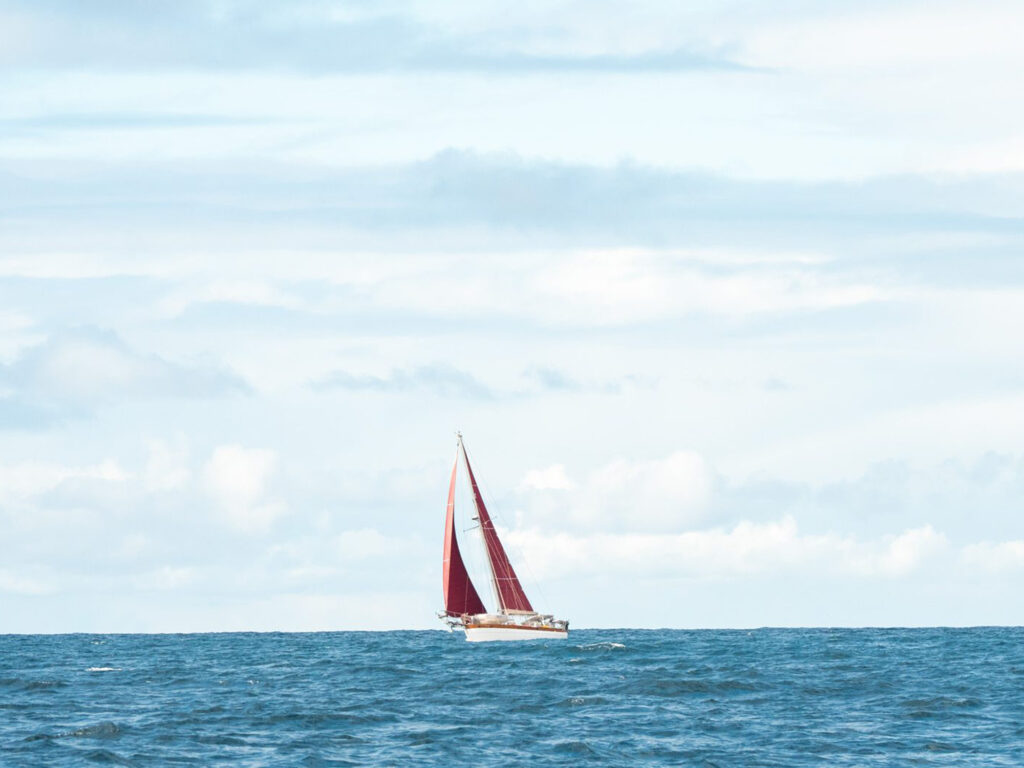 Kessel’s tanbark sails decorated the horizon as we settled in for the passage.
Marissa Neely
Kessel’s tanbark sails decorated the horizon as we settled in for the passage.
Marissa Neely
As soon as we were secure we launched our tender, Winglet. Chris made a mad dash to the post office to retrieve our ticket out of California—or so we thought.
Packing paper was everywhere as Chris unearthed our friend’s Starlink router from the box. Peter came over for the moment of truth, but when we plugged it in, we were shocked: still no signal. We decided to table the diagnosis until the following morning.
The Santa Ana wind event came and went, bringing 2- to 4-foot chop into the mooring field. We rocked and rolled, and abandoned ship when the sun came up to wait out the sea state before returning to troubleshoot our Starlink issues. After a lovely breakfast and computer session at Catalina Coffee & Cookie Co., we made our way back to Avocet.
“It’s your inverter, bro,” Peter said, after measuring the hertz with a multimeter. Our Renogy 2000 pure sine wave inverter seemed to have served us well, but thinking back, it had started to show signs of failure when we returned to Morro Bay after the holidays. We theorized that during one of the storms, a surge led to its demise, going unnoticed until we tried to use Starlink when sailing south.
Fortunately, Peter’s mom, Charlotte, was planning on visiting the next day. We could ship an inverter to her that she could bring to the island. We could only get a Victron 500VA inverter in time, but it would suffice to run our Starlink and charge our laptops. We slept better that night, thinking the issue was resolved.
Of course, it was not. Charlotte arrived by ferry the next morning—but not before the unthinkable happened. It was 8 a.m. I was drinking coffee in the cockpit when Peter arrived on his Ocean Craft aluminum dinghy to say hello. He had just pushed off from Avocet when he dropped his phone in the drink. I called his crew, who relayed the info to Charlotte.
Within an hour, Mama Metcalfe was aboard Avocet with the inverter in hand.
Still no service. Profanities were exclaimed. The problem had to be our dish.
Peter took over as project manager, creating a list of options for us all. He needed a new phone, so his crew went back to the mainland with Mama Metcalfe. Our friends back in Ventura said we could use their dish, which Peter’s sister could get to from her house. That dish ended up on the ferry to Avalon, bound for us.
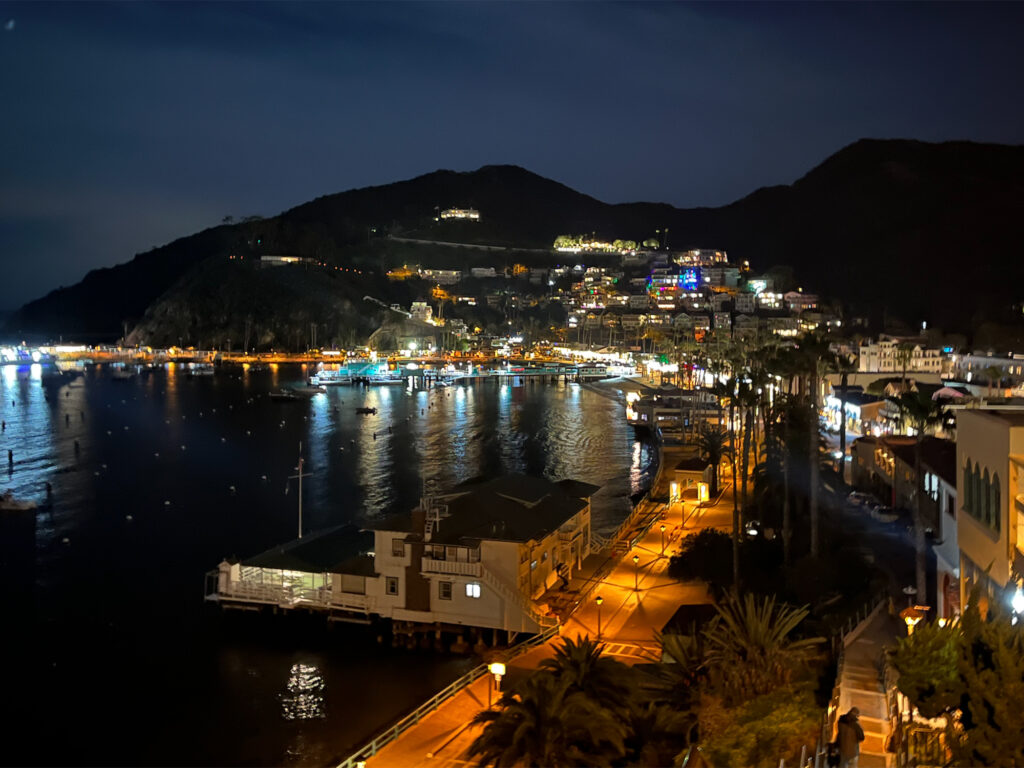 The Avalon waterfront
Marissa Neely
The Avalon waterfront
Marissa Neely
We spent our last night out on the town, with nachos for dinner despite the fact our following months would be full of Mexican cuisine. After we ate our weight in chips and cheese, we walked to one of the best vantage points that overlooked Avalon Harbor. As always, Chris had his camera for keepsakes.
I couldn’t sleep that night, full of anxiety, excitement and fear for all the things to come. Morning came all too soon. My phone lit up with a message as the ferry arrived, and Chris went to retrieve our dish.
We set up all the components and plugged them in, finally seeing results. Tears cascaded down my cheeks from thinking about how amazing our friends are. With a steady connection, we could finally depart for Mexico, and did exactly that as soon as the dinghy was on deck.
We were doing it! After years of dreaming, months of scheming and weeks of uncertainty, we pointed Avocet’s bow south and set our course for Ensenada, Mexico. The rugged shape of Catalina shrank off our stern, and the snowcapped mountains of California’s Sierra Nevada disappeared. We knew we were getting closer to the promised land, but we had 130 nautical miles ahead of us.
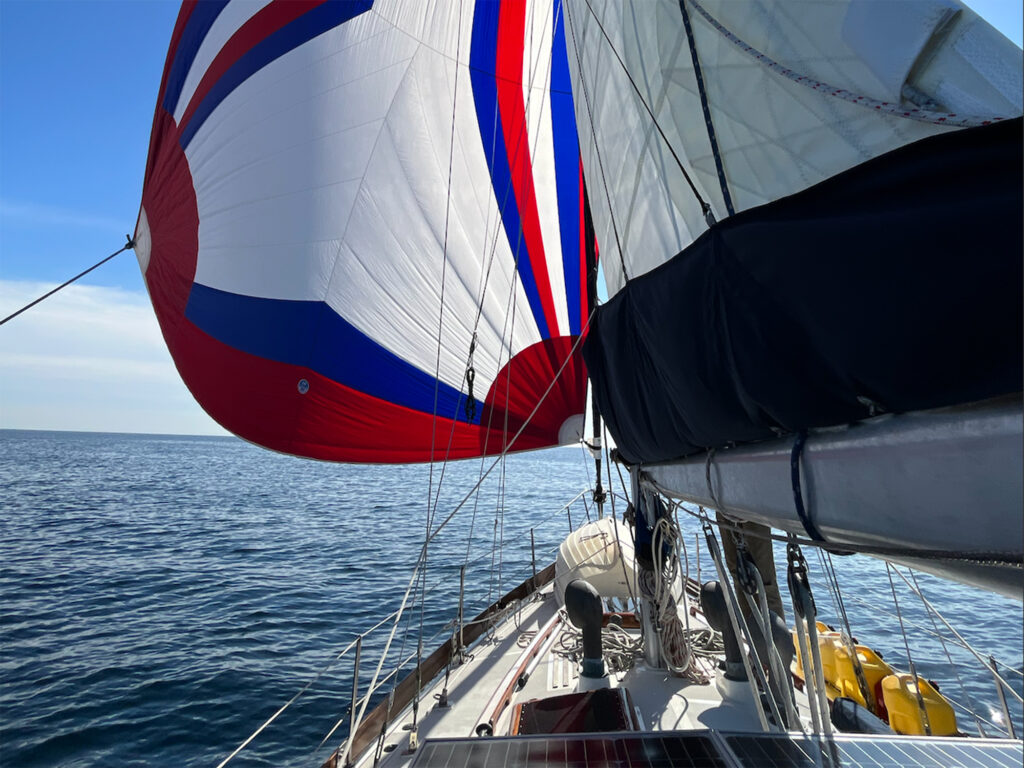 Mexico, here we come!
Marissa Neely
Mexico, here we come!
Marissa Neely
Kessel’s tanbark sails decorated the horizon behind us as we settled in for the passage. It was nice to chat back and forth on the VHF radio, which we would soon learn made night passages go by a lot faster. Our stereo played Mexico by Cake, which had been our rally song since Morro Bay, inspiring us to keep going because eventually the lyrics would ring true, and by the grace of Poseidon they finally did.
The post Sailing Avocet: Comms Failure appeared first on Cruising World.
- Home
- About Us
- Write For Us / Submit Content
- Advertising And Affiliates
- Feeds And Syndication
- Contact Us
- Login
- Privacy
All Rights Reserved. Copyright 2025, Central Coast Communications, Inc.